Canvasback and Pine Warbler Ducks
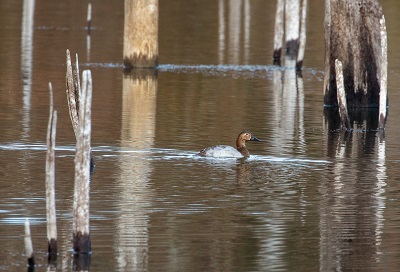
Winter ducks have started to make their way to our area and this female Canvasback was the first of the year spotted in November by our Park System Naturalist staff at the Manasquan Reservoir.
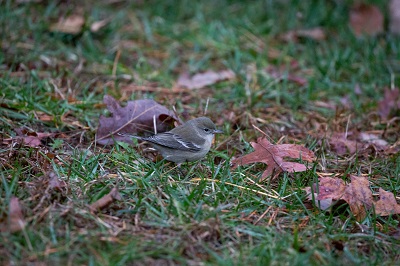
This female Pine Warbler was an unexpected late visitor for December when it was spotted hunting for insects on a particularly warm afternoon on the front lawn of the Manasquan Reservoir Environmental Center. (posted 12/17/2020)
King Eider, Common Eider, Black Scoter, Surf Scoter, White Winged Scoter and Harlequin Ducks at Seven Presidents Oceanfront Park
Seven Presidents Oceanfront Park is a great location to go sea watching. This is especially true in the winter months when many sea duck species appear. Two difficult-to-find in Monmouth County species - the King Eider and Harlequin duck - were seen during the same visit to the park in early December along with the Common Eider, Black Scoter, Surf Scoter and White Winged Scoter.
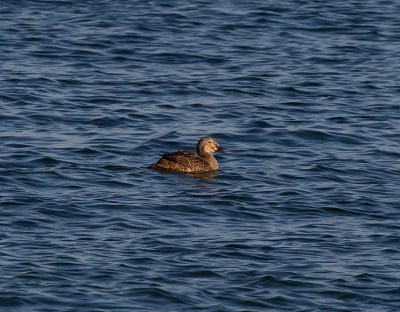
King Eider
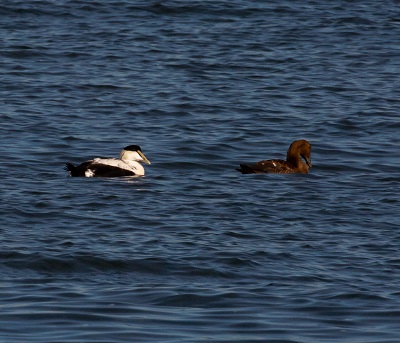
Common Eider
This particular King Eider was a female. While it does not have the male’s ornate coloration, it still has a sloping profile to its head. Compared with the Common Eiders, she is slightly smaller in size and has a lighter coloration of molted brown. Common Eider females have a much darker coloration while the male has a spectacular black and white appearance with yellow flash on the front slope of its head. A few immature and eclipse males were mixed in with the group.
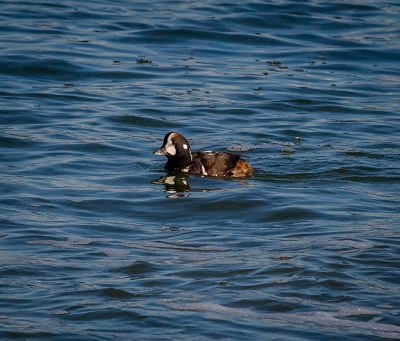
Harlequin Duck
Another highlight that day was seeing an immature male Harlequin Duck with almost adult plumage. A smaller duck than the Eiders, it has a distinctively smaller bill, a white facial crescent, and a spot on its head.
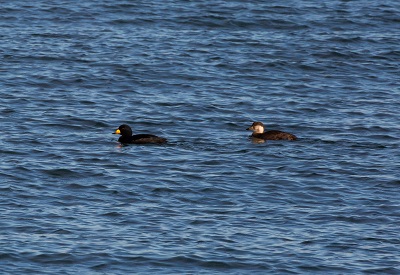
Black Scoter
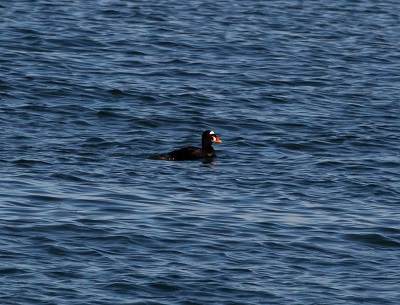 Surf Scoter
Surf Scoter
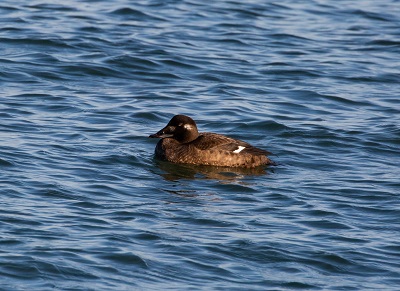
White Winged Scoter
Also seen that day were a number of scoter species including the Black Scoter, the Surf Scoter, and the White-winged Scouter. Male Black Scoters have a distinct orange knob at the base of their bill while the Surf Scoters have a distinct large sloping orange bill with a white base. They can have a red tinge as well as a distinctive white patch on the back of their neck. While only a female White-winged Scoter was photographed that day, both males and females have a distinctive white wing patch. (posted 12/17/2020)
Wilson Snipe at Clayton Park

It’s always a great idea to scan waterways with an extra careful eye because you never know what may be hiding in plain sight. These Wilson Snipe are masters at camouflage, if you look closely you can see a distinguishing mark referenced as the “snipe stripes” running down its back. (posted 12/15/2020)
Bald Eagle, Fox Sparrow, and Pine Siskin & Nashville Warbler
at Crosswicks Creek Park
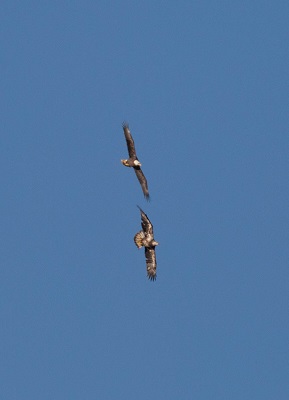
Late fall is a great time to see birds as they are migrating south for the winter season and Crosswicks Creek Park was a great location to see some seasonal highlights this year. There were multiple Bald Eagles seen on the same day over the pond. Pictured above are two Bald Eagles. One is an adult with the white head and white tail present, and the other is immature and does not yet have its adult plumage.
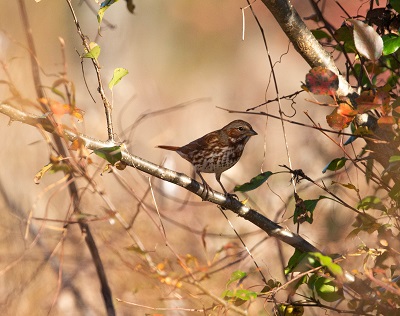
October and November are the prime migration time so it’s always good to keep your eyes open to the skies above. However, don’t forget to keep your eye open to the smaller birds as well. November is a great time to see some more cryptic and harder to find birds as well. For example, Fox Sparrows start to appear in our area and can be notoriously difficult to locate because of their preference for dense brushy areas.
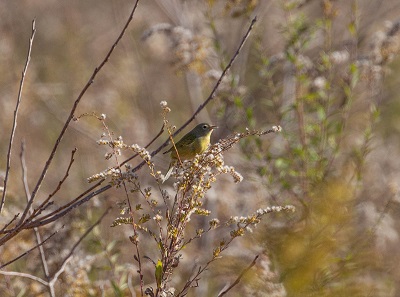
Nashville Warbler
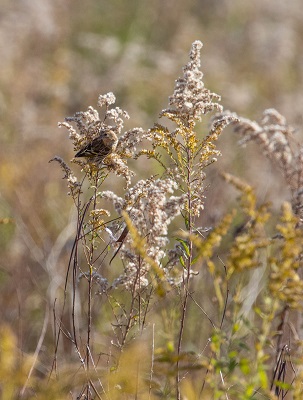
Pine Siskin
It also isn’t too late to find a warbler either. This Nashville Warbler was a nice find, spotted feeding in and amongst the tall grasses along the Crosswicks Creek field. It was joined by a few Pine Siskins - which are not common visitors - from further north. This year, in particular, has been an irruption year and some of the northern finch species are heading further south. (posted 12/15/2020)
Red-breasted Nuthatch
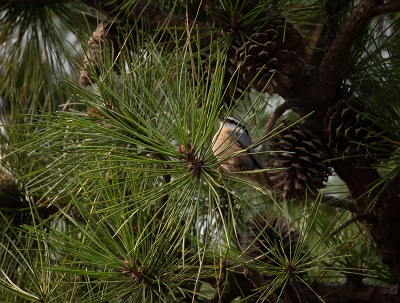
It’s not every year we get this fall/winter visitor from the far north - the Red-breasted Nuthatch. This year is slated to be an irruption year for these birds and may be a great chance to see this beautiful species as they head further south than usual (into New Jersey and beyond) in search of food. (posted 10/29/2020)
Juvenile Eastern Box Turtle & Fowlers Toad
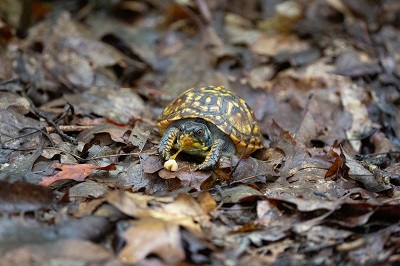
Juvenile Eastern Box Turtle
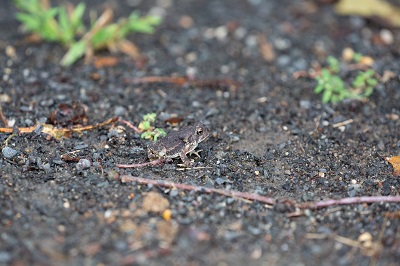
Juvenile Fowlers Toad
These juvenile animals were recently spotted during a walk at the Manasquan Reservoir, Howell. This beautiful juvenile Eastern Box Turtle was foraging along the trail edge and caught in the act of eating what appears to be a slug. Just moments later along the same trail we were lucky enough to spot this stunning juvenile Fowlers Toad camouflaging in with the trail gravel. (posted 10/2020)
Hawks and Falcons
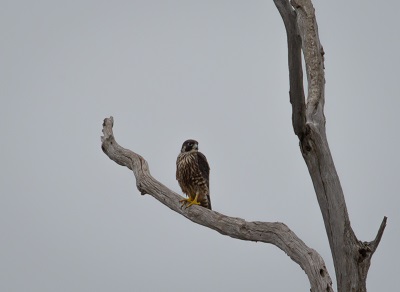
Peregrine Falcon
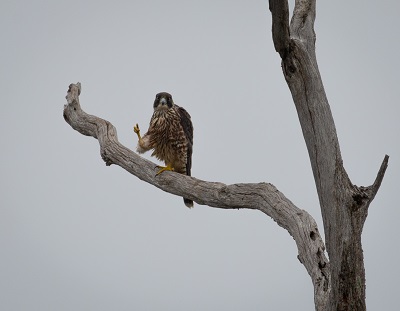
Peregrine Falcon
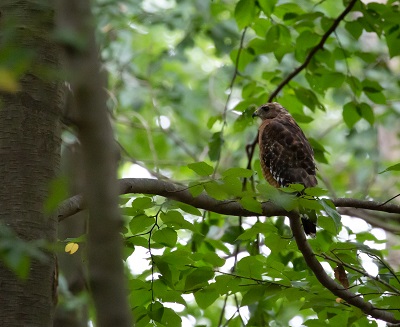
Red-Shouldered Hawk
Fall migration isn’t only for shore birds and warblers. Hawks and falcons also congregate for fall migrations, making this a great time of year to get out and see them. At the Manasquan Reservoir, we are fortunate to have a few of these birds stop along their journey. (posted 9/30/2020)
Warbler Migration
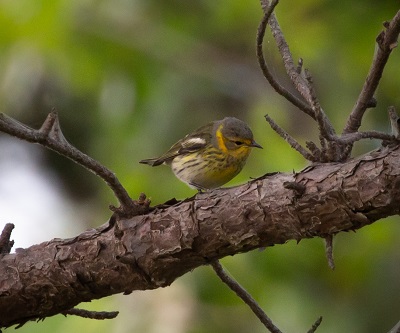
Cape May Warbler
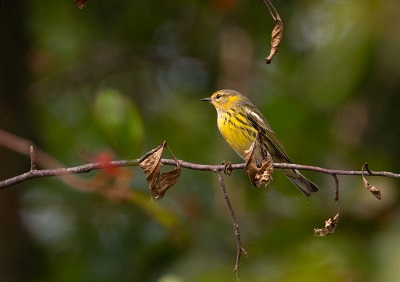
Cape May Warbler
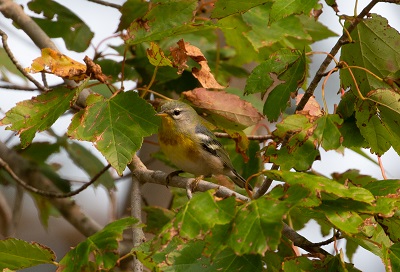
Northern Parula
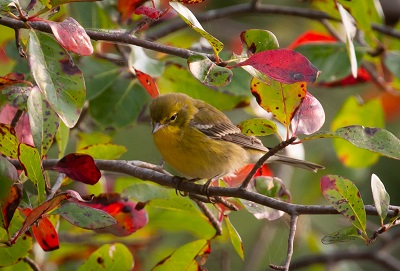
Pine Warbler
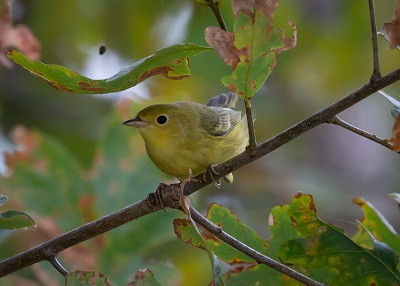
Yellow Warbler
A highlight of the year for birders can be the warbler migration. In the fall, these birds can be extra difficult to identify because they have lost their flashy breeding plumage and have their duller, non breeding plumage. They also do not call as much as they do in the spring. However, for dedicated birders, fall is a wonderful time for a peck of color. (posted 9/28/2020)
Lookin’ Solid!
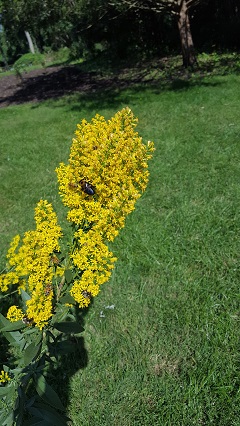
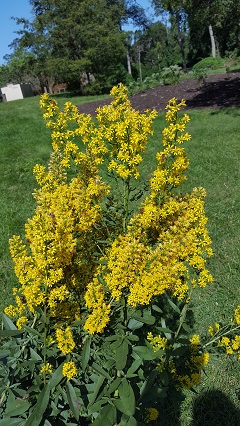
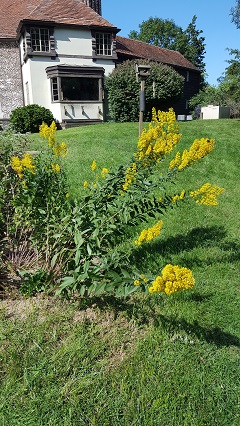
Showy Goldenrod is a favorite autumn wildflower. It’s Latin name is Solidago speciosa, and it’s just one of many species of native goldenrods that flower throughout Monmouth County this time of year. Showy Goldenrod can be identified from the rest of the goldenrods by its rather large club-shaped blooms and stalks originating from a single clump on the ground.
This plant is not just here for good looks; it serves a vital role too! This end-of-season bloomer provides valuable nectar and pollen for native bees and butterflies. These pollinators, whether they are getting ready to migrate south or lay eggs for overwintering locally, will use this food to accomplish those goals.
Think about adding some in your yard to help create a wonderful pollen-nation spectacle! (posted 9/28/2020)
Manasquan Reservoir, Howell
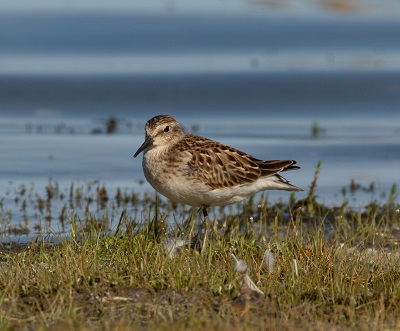
Least Sandpiper
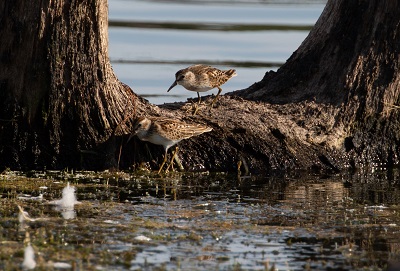
Least Sandpiper on timber
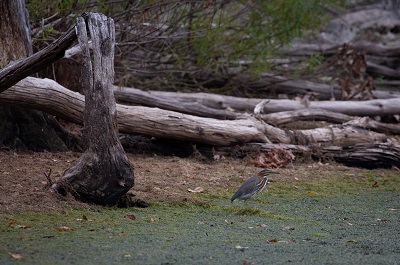
Green Heron
As the water level falls at the Manasquan Reservoir, birds take advantage of the new exposed beach to feed. Least Sandpipers and other shore birds have been spotted stopping during their migration. A Green Heron was seen stalking its prey by slowly walking along the shore. (posted 9/25/2020)
Golden Hedgehyssop (Gratiola auroea)

This delicate native perennial plant can be found en masse along the shore of the Manasquan Reservoir, Howell. Averaging 6 inches in height, the plant produces small, bright yellow tubular flowers on its upper leaf axils. Its leaves are opposite, meaning they’re positioned directly across from one another. Often creating a green and yellow carpeting effect due to its large numbers, Golden hedgehyssop is associated with coastal plain habitats with blooms occurring from July to September. Interestingly, it is listed as an Endangered Species due to loss of habitat, pollution and invasive species in neighboring Pennsylvania. (posted 8/3/2020)
Dragonhunter Dragonfly
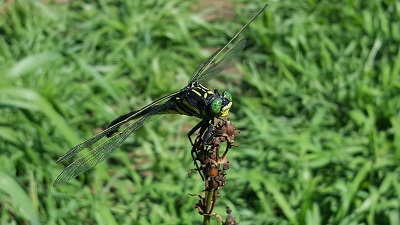
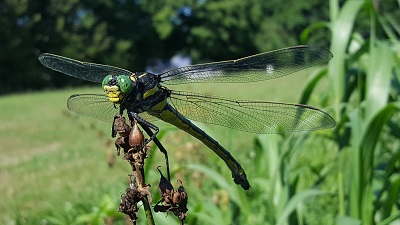
This Dragonhunter dragonfly was found basking horizontally on some flower stems at Clayton Park. It is the largest dragonfly in the Clubtail (Gomphidae) family of dragonflies. It is a predatory dragonfly that eats other dragonflies, damselflies and butterflies. (posted 7/15/2020)
Red Belly Turtle
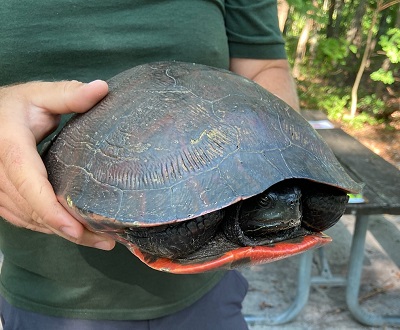
This Red bellied Turtle was found at the Manasquan Reservoir Environmental Center, Howell, trying to cross the road in the parking lot after it must have ventured out of the reservoir to find a spot to nest. Our Park System Naturalist staff helped her along to the safety of the water's edge, as that was the direction she was headed. Female Red bellied turtles can be quite large and are the largest species of basking turtle in New Jersey. They are commonly seen basking in the sun on floating logs during the day. (posted 7/10/2020)
Mammatus Clouds
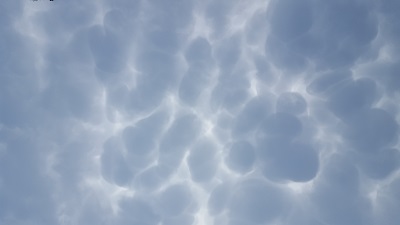
These Mammatus clouds were a beautiful surprise to see on one summer afternoon as thunder storms passed the Manasquan Reservoir Environmental Center, Howell. According to BBC.com, their name derives from the Latin mamma, which means “udder” or “breast”. Essentially, Mammatus are upside-down clouds formed from sinking pockets of cold, moist air. None of our Park System Naturalist staff could remember ever seeing such a cloud formation but it reminded us of the wonder of nature. (posted 7/10/2020)
Transformers…Loopers in Disguise
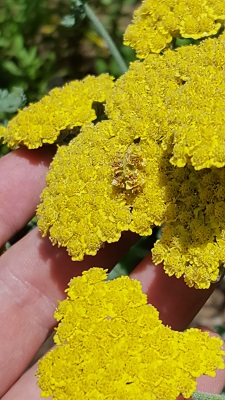
One sunny afternoon, I found myself admiring the yellow yarrow behind the Huber Woods Environmental Center. Out of the corner of my eye I noticed a slight movement, but when I turned to see what it was, I saw nothing. I figured it was most likely a small bee buzzing around, but I decided to have a closer look just in case it was something more. Upon closer inspection, I happened across this curious invertebrate!
Synchlora aerata, or the Camouflaged Looper, is a small caterpillar that feeds on various types of flowers. What makes them absolutely fascinating is their ability to camouflage themselves using a strategy called self-decoration. There are only a handful of species in the world that perform this type of behavior. As the caterpillar feeds atop a flower, it will actually cut and attach bits and pieces of said flower in order to blend into its surroundings. Once it decides to crawl onto a different plant, it’ll remove the old flower bits and go for a completely new look, all in the name of hiding from predators. (posted 6/29/2020)
Red Milkweed Beetle
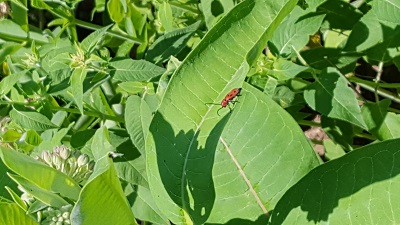
Milkweed plants provide hosting duties for more than one insect, not just the Monarch Butterfly. Pictured above is the Red Milkweed Beetle, spotted in the Huber Woods Discovery Path Pollinator Garden. Native throughout the Eastern United States, this insect can be found wherever there is common milkweed growing.
Red Milkweed Beetles are known for their vibrant red color, with tiny spots scattered along their bodies. Adults emerge in early summer, and the females will eventually lay their eggs on the lower stems of milkweed plants. Their larva will then overwinter inside the roots and pupate around springtime.
It is no coincidence that both the Monarch Butterfly and Red Milkweed Beetle are brightly colored. Because they feed on the toxic foliage of milkweed, they themselves become poisonous. The evolutionary trait is called aposematic coloration.
You never know what you’ll see when you stop and look at the flowers.
Common Snapping Turtle
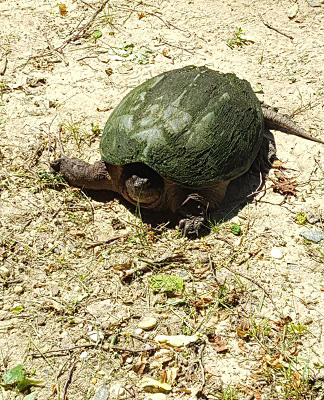
Being such a large specimen, the Common Snapping Turtle can be a little intimidating at first sight. Growing up to fifteen inches, long, this native reptile packs one powerful bite. While typically showcasing a black or brown shell, the algae covering this individual’s shell suggests it recently left one of our nearby ponds at Huber Woods. Snapping Turtles can also be identified by their large head, long tail, and their small plastron (the bottom half of the shell).
Most likely due to their inability to retreat inside their shells, Snapping Turtles may become aggressive when cornered on land. Female Snapping Turtles prefer to lay their eggs in a sandy substrate near a permanent water source. If you find yourself walking along a sandy trail and notice some broken egg shells, it’s probable that a predator like a fox or raccoon raided the turtle’s nest. Fortunately, one female can lay dozens of eggs in a single nest. (posted 6/25/2020)
Free Seining at the Bayshore Waterfront Park
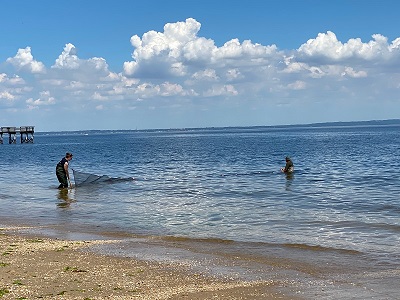
It wouldn’t be summer without free seining at the Bayshore Waterfront Park, Port Monmouth. Staff with the Monmouth County Park System are happy to help people discover some of the many sea creatures living near the shoreline of Sandy Hook Bay using a 30-foot seine net. Recently, an adult female horseshoe crab was found as well as juvenile Atlantic silversides, jellies, and the molts of blue crabs and horseshoe crabs. The fun takes place every Monday, Wednesday, and Friday from 11 a.m. to 12 p.m. on the beach near the historic Seabrook-Wilson House. The last day for free seining is Friday, August 21. Everyday is different, you never know what will we find! (posted 6/22/2020)
Promethea Silkmoth
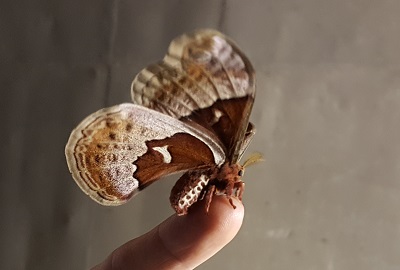
During our recent Summer's Wonderful World of Moths program, Park System Naturalist Paul Mandala led participants in catching and identifying some moth species found in Monmouth County. The highlight of the evening was catching one of the big silk moth species, a Promethea Silkmoth female. The Promethea silkmoth, Callosamia promethea, is one of the larger species of moth you can find in Monmouth County with a wingspan of up to about 3.5 inches. They have sexual dimorphism with the female Promethea (pictured) having lighter brown coloration while the male is darker black in coloration.
(posted 6/18/2020)
Warblers
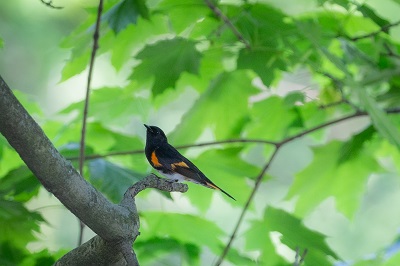
American Redstart
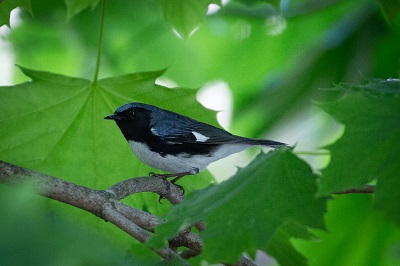
Black Throated Blue Warble
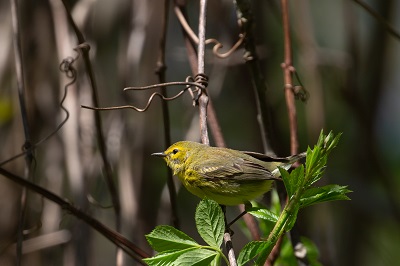
Prairie Warbler
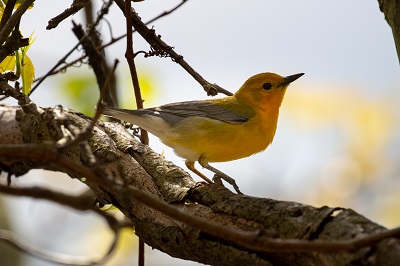
Prothonotary Warbler
Vireos
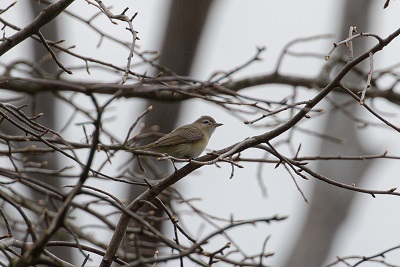
Warbling Vireo
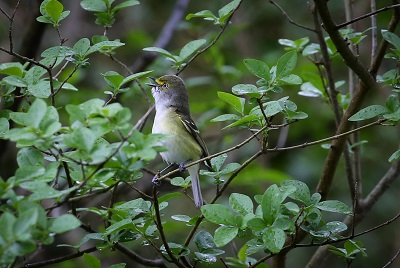
White-eyed Vireo
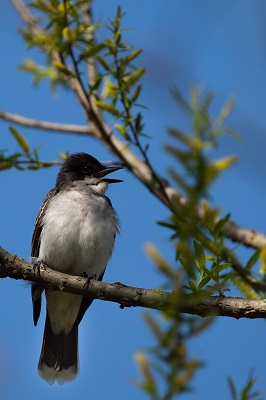
Eastern Kingbird
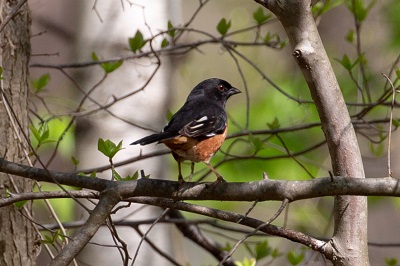
Eastern Towhee
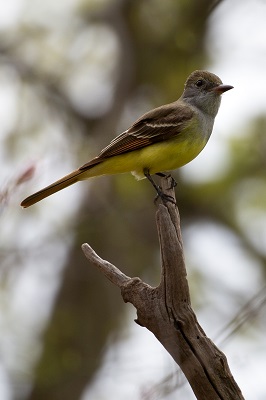
Great Crested Flycatcher
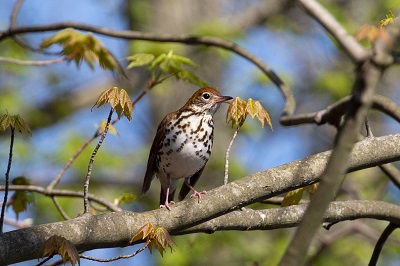
Wood Thrush
Clayton Park, Upper Freehold
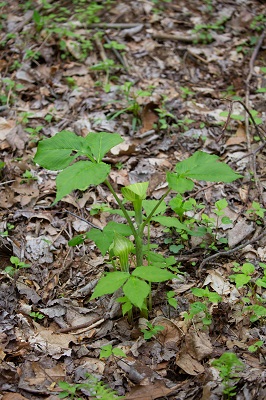
Jack in the Pulpit
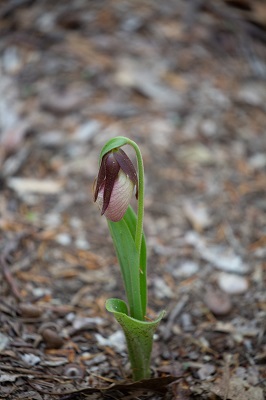
Lady Slipper Orchid
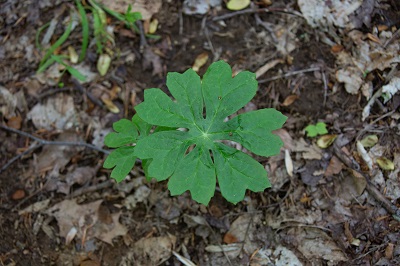
May Apple
Eastern Tiger Swallowtail at Manasquan Reservoir
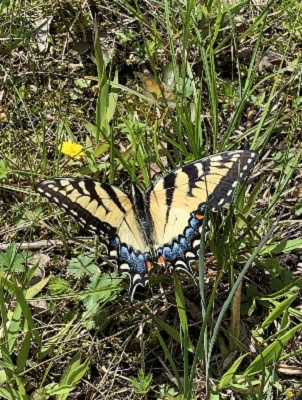
This beautiful female Tiger Swallowtail was captured recently by one of our Park System Naturalists. This species overwinters as a pupa and emerges in spring. Females can be light or dark and only females have blue on the hind-wings, as we see with this individual. Males resemble a light female but smaller. Major food plants include wild black cherry and tulip tree. (posted 5/7/2020)
Manasquan Reservoir: Hatching Begins for Bald Eagles
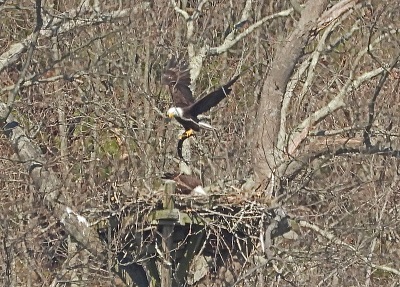
Male eagle bringing a fish to the nest. (photo courtesy of A. Merrill)
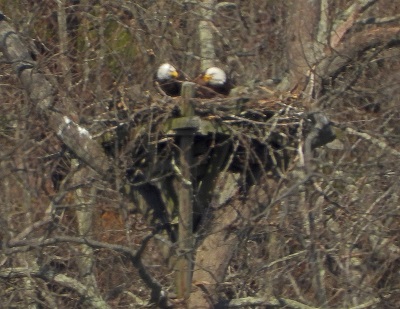
Bald eagles nesting (photo courtesy of A. Merrill)
At the Manasquan Reservoir Environmental Center, we have been eagerly watching the eagles’ nest anticipating hatching. This week we have been observing the adult eagles reaching down into the nest and delicately feeding their chick(s). This is a clear sign that hatching has occurred. Eagles typically have between one and three chicks per season. We do not know the number of eaglets at this time. The newly hatched offspring are small and weak. We cannot see them until they are strong enough to hold their heads up. It may be a couple of weeks until we know how many there are.
Please remember that nesting is an extremely sensitive time for eagles. A nest can fail due to disturbance caused by people trying to get too close. Please do not approach the nest tree or enter any protected area. The eagles’ nest can be viewed from the Manasquan Environmental Center, weather permitting. Our hours of operation are 10 a.m. to 4:30 p.m. daily. Stop by to find out more! (posted 3/12/2020)
Salamander
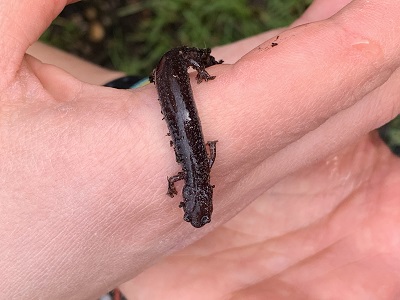
This small amphibian is a vital component of the forest food chain as it is both a predator of a variety of macroinvertebrates and prey for a variety of small vertebrates. Even with its small size, nocturnal behavior, and lack of vocalizations, the red-backed salamander (Plethodon cinereus) is commonly encountered under leaf litter and woody debris on the forest floor. A member of the lung-less salamander family (Plethodontidae), this salamander lacks lungs, absorbing oxygen through its skin. There are two color phases of the red-backed salamander. The “redback” phase has a gray or black body with a red or orange stripe down its back; whereas the “leadback” phase (above, found in our greenhouse) has no striping and is purely grey or black. (posted 2/11/2020)
Razorbill
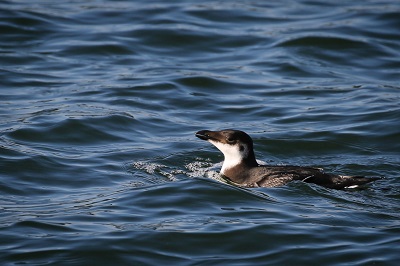
Razorbill, Alca tord, Non breeding plumage, spotted just offshore in Monmouth County.
A razorbill, a pelagic species of bird in the Auk family, was recently spotted swimming just off a jetty in Monmouth County. Razorbills are a rare winter visitor to Monmouth County because of its pelagic lifestyle, meaning that it spends most of its life in open oceans of the Northeast Atlantic except to lay eggs and raise young. At those times, they come ashore to nest further north. In the winter, they come down as far as the coast of New Jersey in search of food. They can be very difficult to see from shore, usually requiring a birding scope, binoculars or a ticket on pelagic boat cruise. Every once in a while, they do come in close enough to shore to get a picture or see with the naked eye. There is always a small chance you could encounter one swimming along the ocean, for example at Seven Presidents Oceanfront Park during the winter months. For those tough enough to brave the cold in winter, sometimes there is a nice reward to be found along our beautiful coastline. (posted 2/10/2020)
Bald Eagles are Incubating at the Manasquan Reservoir!
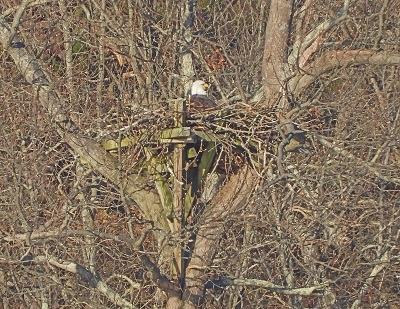
Photo courtesy of Aubrey Merrill
These are exciting times at the Manasquan Reservoir located in Howell! On January 28, our resident Bald Eagle pair began incubation. From now on, one of the adults will almost always be seen on the nest. Eagles begin sitting immediately upon laying their first egg. They can produce up to three eggs over the following few days. As incubation requires 35 to 40 days to complete, we expect hatching the first week of March.
Eagles are known for using the same nest year after year. However, this pair has relocated their nest essentially every year since 2012. This year they are located on a man-made frame that was built for nesting eagles by the New Jersey Fish and Wildlife. They last nested at this location in 2016.
Nesting Bald Eagles are very sensitive to disturbance by humans. Approaching the nest could cause them to abandon their eggs or young. Please do not approach the nest or enter any protected areas. The eagles’ nest can be viewed from the Manasquan Environmental Center. Our hours of operation are 10 a.m. to 4:30 p.m. daily. Stop by to find out more!
Clubmoss at Freneau Woods Park
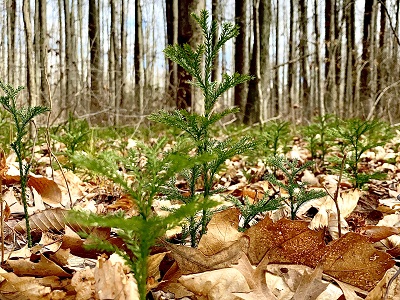
This picture might look like a bunch of juvenile pine trees within the winter woods, but don’t be fooled! They are actually a type of clubmoss or lycophyte. But even this can be confusing, because clubmosses are not a type of moss. Clubmosses are actually an ally of ferns. Clubmosses evolved some 410 million years ago and along with ferns dominated the swamps or wet woods of the Carboniferous geological period. Clubmosses, sometimes known as ground pine, are all perennial evergreen plants. Individual plants in many species are connected by horizontal stems that run above ground or below ground. Clubmosses are not flowering plants, but just like ferns, will reproduce sexually by spores. (posted 1/29/2020)